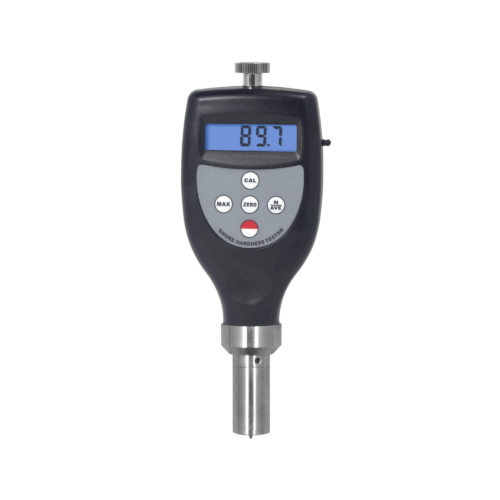Our Location
Hardness means a material’s ability to resist localized deformation. This quality becomes particularly important when selecting a material for environments that involve abrasive particles that can cause wear. Softer materials tend to develop indentations, while harder materials are better at maintaining their shape and resisting such changes.
Hardness should be considered alongside other material properties such as strength and elasticity. For instance, many hard materials are often brittle, which restricts their applications.
In this blog, we will dig into the concept of material hardness, how it is measured, and how to compare different units of measurement.![]()

Table of Contents
ToggleMaterial hardness refers to a material’s ability to resist deformation, scratching, penetration, and indentation under applied force. In simpler terms, it is how well a material maintains its physical properties when subjected to force.
Hardness varies among different materials, with steel typically exhibiting higher hardness compared to softer materials like tin. Additionally, some non-metallic materials, such as wood and plastics, can exhibit characteristics similar to those of softer metals.
The hardness of a material is influenced by several factors, including its plasticity, ductility, strain, toughness, elastic stiffness, strength, viscosity, and viscoelasticity.
Materials respond differently to various types of loading. For instance, a metal that can bear a one-time, critical impact might not behave the same way under continuous loading.
Each case must undergo hardness testing to ensure informed application decisions.
The three types of hardness are scratch hardness, rebound hardness, and indentation hardness. Measuring each type requires different tools. Additionally, the same material can exhibit varying hardness values depending on the type.
This type of hardness describes a material’s resistance to surface scratches. Scratches are narrow, continuous indentations on the upper layer caused by contact with a sharper, harder material.
Scratch testing is commonly used for brittle materials like ceramics, which do not experience significant plastic deformation. It is crucial to consider scratch hardness, as some materials are susceptible to scoring in specific applications.
Let’s take the example of an engine cylinder liner. Scratching or scoring on the liner can occur for several reasons. The liner surface comes into contact with various metals, such as piston rings, as well as with foreign particles in fuel or lubrication oil. Additionally, improper seating of the liner can also contribute to this issue.
The abrasive particles can scratch surfaces, ultimately degrading engine performance and increasing maintenance, spare parts, and fuel costs over time.
During the design stage, selecting the appropriate metal involves considering the hardness of the materials it will contact. The hardness of the liner should be greater than that of the interacting materials in order to prevent potential issues.
Rebound hardness is more related to elastic hardness than plastic hardness. The material absorbs energy upon impact and returns it back to the indenter.
An indenter is a reference material utilized for hardness testing. Dynamic hardness is commonly measured by falling a diamond-tipped hammer onto the test piece and recording the hammer’s bounce after it strikes the surface.
The closer the height is to the initial dropping height, the higher the rebound hardness value.
This hardness type describes a material’s resistance to permanent deformation under a continuous load.
Indentation hardness is the term engineers and metallurgists commonly use when discussing hardness. Measuring this value is crucial, since continuous loading is the most prevalent form of loading experienced by metals.

It is important to consider the factors that affect the hardness of a material:
Consider materials as collections of many small grains, similar to a scoop of sand. When the grains are large, there are fewer obstacles present. However, if the grains are small, numerous tiny hurdles will exist.
Smaller grain sizes generally create more obstacles that can interfere with material bending. This means that tiny defects or irregularities may affect how materials bend. Consequently, an increased number of obstacles often results in higher hardness.
Think of materials as being composed of tiny building blocks. Some materials arrange these blocks in an orderly fashion, similar to a well-organized stack of bricks (crystalline structure).
Some materials are organized more systematically, resembling a well-structured set of Legos, while others have a more chaotic arrangement. The way these blocks are organized significantly affects their hardness. Materials with a clear, ordered structure tend to exhibit different hardness characteristics compared to those with a more random, amorphous arrangement.
Now, let’s discuss temperature. Picture your material as a group of guests at a party. At higher temperatures, it resembles guests mingling freely and moving easily, which increases the atoms’ movement.
When temperatures drop, the guests will begin to freeze in place. In materials, reduced atomic mobility at low temperatures can increase their hardness. You could say they become more resistant to changes because the atoms are less able to move around.
Many machinists often confuse SI units of hardness with those of pressure. The standard International (SI) unit of hardness is N/mm², also known as the Pascal. In contrast, the SI unit for pressure is N/m², which can be expressed as kg·m⁻¹·s⁻². Each hardness class mentioned has its own measurement scale.
The units of hardness are derived from different measurement methods, so they cannot be directly compared. However, a conversion table is available to help with comparisons. We use the term “manage” because these comparisons cannot be exact, but they do provide a reasonable indication.
The Leeb Hardness Value (including HLD, HLE, HLS, etc.), Rockwell Hardness Number (such as HRA, HRB, HRC, etc.), Brinell Hardness Number (HB), and Vickers Hardness Number (HV) are some of the most commonly used units for measuring hardness. The table below compares these measurement units and their conversions.
| Brinell | Rockwell | Rockwell | Vickers |
| HB | HRC | HRB | HV |
| 469 | 50 | 117 | 505 |
| 468 | 49 | 117 | 497 |
| 456 | 48 | 116 | 490 |
| 445 | 47 | 115 | 474 |
| 430 | 46 | 115 | 458 |
| 419 | 45 | 114 | 448 |
| 415 | 44 | 114 | 438 |
| 402 | 43 | 114 | 424 |
| 388 | 42 | 113 | 406 |
Material testing involves a series of processes that measure properties such as ductility, strength, reactivity, and hardness in materials like plastics, metals, and ceramics under various conditions. The results of these tests provide valuable guidance for designers and product engineers, helping them assess material compatibility for their projects.
Different industries utilize various types of hardness tests. Here are some of the standard methods commonly used.
The Rockwell hardness test is a widely applied method for measuring material hardness, primarily due to its quick execution and accurate results.
The procedure involves using both a minor load and a significant load. First, the minor load is applied, followed by the considerable load, which is then subjected to an indenter. The difference in penetration depths of the materials under both loads is used to determine the hardness value.
There are several types of Rockwell scales, but the two most commonly used for measuring material hardness are HRB (Rockwell B scale) and HRC (Rockwell C scale). The HRB scale is utilized to assess the hardness of lighter metals, such as aluminum, while the HRC scale is intended for measuring the hardness of heavier metals, like steel.
As one of the earliest scale units to measure material hardness, the Brinell Hardness Number is widely used to quantify the hardness of metal alloys.
The Brinell test involves using either a carbide ball or a hard steel ball to press a specific diameter into the material’s surface under a standardized load. The dimension of the resulting indentation is then measured, and the Brinell Hardness Number (BHN) is calculated by dividing the involved load by the surface area of the indentation.
The BHN is primarily used for materials with smooth or very rough surfaces, such as coarse-grained materials, castings, and forgings. This is mainly because it provides more accurate measurements than other scale-unit methods.
Unlike the first two methods discussed, the Vickers hardness test utilizes a diamond pyramid indenter. This indenter is pressed into the material with a specific load, and the diameter of the resulting indentation is measured to determine the Vickers Hardness Number (VHN). In order to calculate the VHN, the applied load is divided by the area of the indentation.
The benefit of this hardness testing method is its versatility, as it can be used in a wide range of materials, from lighter to heavier types, including both plastics and metals. The Vickers scale is favored by researchers and in applications where precise hardness values are crucial, mainly due to the diamond indenter’s capability to measure indentations with high accuracy.
Named after Friedrich Mohs, a 19th-century mineralogist, the Mohs Hardness Scale is unique among other hardness scales because it qualitatively assesses a material’s ability to scratch another.
In 1812, Friedrich Mohs developed a scale ranging from 1 to 10, in which 1 refers to the softest material and 10 refers to the hardest. This scale establishes that diamonds are the hardest known substance. It also indicates that materials with a higher number on the scale can scratch those with a lower number.
Jewelers and geologists widely use the Mohs scale to test gemstones and minerals, helping identify materials by their resistance to scratching. While this test method is not as precise as some other techniques, it remains the simplest hardness test that can be performed in the field.
Using a material hardness chart or scale is one of the simplest ways to determine the hardness of various common materials. This chart presents the hardness values of several materials using different measurement methods. For example, the hardness values for metals such as aluminum and titanium are illustrated in the chart above, using Brinell’s scale along with additional testing methods.
Hardness testing is valuable in various industries and applications, including:
Hardness testing allows manufacturers to create tools that maintain sharp edges and shapes under stress. These tools, such as cutting tools and molds, are tested to ensure they can withstand operational loads.
Biomedical implants, such as prosthetics, surgical instruments, and orthopedic implants, undergo hardness testing to ensure their longevity, durability, and patient safety during prolonged use.
Lightweight materials used in aerospace applications need to exhibit high resistance to deformation. Hardness tests ensure these parts meet the required quality standards.
Hardness testing is essential for quality assurance in production lines across the automotive and electronics industries. It helps identify material inconsistencies and manufacturing defects.
To select the right material for your project, it is crucial to conduct a thorough hardness test. There are several methods available for testing material hardness. It is advisable to consult a professional company for expert guidance on the hardness of your chosen material.

